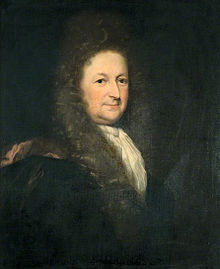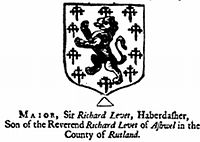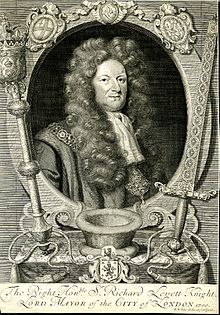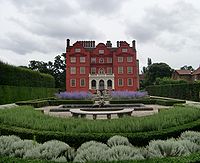Richard Levett
Richard Levett | |
|---|---|
 1699 portrait by Godfried Schalcken | |
| Born | |
| Died | 20 January 1711 Kew, England |
| Resting place | St Anne's Church, Kew, Richmond-upon-Thames |
| Spouses |
|
| Children | Elizabeth, Mary, Frances, Anne, Richard |
| Parent(s) | Richard Levett Katherine Levett |
Sir Richard Levett (died 1711) was an English merchant, politician and slave trader who served as Lord Mayor of London in 1699. Born in Ashwell, Rutland, he moved to London and established a pioneering mercantile career, becoming involved with the Bank of England and the East India Company. Levett was acquainted with many prominent individuals during his time in London, among them Samuel Pepys, John Houblon, William Gore, Sir John Holt, Robert Hooke, and Charles Eyre. He acquired several properties in Kew and Cripplegate.[1]
Early life and career beginnings[edit]
Although born into a once-powerful Sussex Anglo-Norman family (its surname derives from the village of Livet in Normandy), the future Lord Mayor grew up in straitened circumstances after the family lost much of its medieval wealth. Levett's father was an intruding minister[2] and he was ejected in 1660 after the Restoration when the legitimate incumbent returned to the living. Although born with connections, Richard Levett and his brother Francis were thrown onto their own resources, and were as much pioneers in business as they were in society.
Despite their impressive Norman lineage, the Levett brothers were middle-class. They represented an emerging England, an England of meritocracy and hard work that trumped the old aristocratic England. (Perhaps it was not an accident that their father, Rev. Richard Levett, had Puritan sympathies.) The enterprising brothers demonstrated that through hard work, ordinary Englishmen could move into the upper-middle classes. The Levett brothers were abetted in their rise by profound changes in the evolving English economy, with trade opening and feudal privileges diminishing in favour of a growing mercantile middle class. Although Levett was a nominal Tory, he was a free market capitalist by practice.[3]
Levett and his brother Francis began as small haberdashers, trading everything from tobacco to textiles. The sons of a country parson in Rutland, the two Levett brothers imported goods into England, which they then sold to chapmen at fairs across the country, including those at Lenton, Gainsborough, Boston, Beverley and elsewhere. As the British Empire began to expand, bolstered by increasing military might, aggressive merchants like the Levetts leapfrogged other foreign and domestic competitors. From their small operation grew a behemoth, with the Levett brothers using their own ships to import everything from tobacco to linens.

Eventually, their empire became among the largest factors of its day in England, with an immense working capital estimated between £30,000 and £40,000 in 1705, buying tobacco and other goods around the world for import into the English market. The firm they set up came to embrace trade with the Levant (principally Turkey and Syria), India, Africa, the West Indies, North America, Ireland and even Russia. Contemporaneous records show Levett often immersed in the details of arranging shipping terms and trading voyages to places as disparate as French Guinea, Virginia, Maryland and elsewhere. Like many London merchants of the period, Levett was involved in the Atlantic slave trade, transporting Black slaves from French Guinea and various West African ports for sale in the English colonies of Virginia and Maryland.[4]
In 1705, for instance, Levett sent a letter to the Board of Trade and Plantations to complain about interference with his ships. "The Governors of Virginia and Maryland", Levett complained to the Board, "had refused to permit two ships of theirs to saile from those colonies with their ladings.... And it being alleged in the petition that the masters of those two ships (who came away in ballast) were obliged to give security to touch at the Maderas in their way home." The Board directed its agent to "write to the said masters at Bristol for further information in that matter."[5]
The building of a business empire[edit]

By the early eighteenth century, the firm of Sir Richard Levett and Company had become one of England's largest, dominating especially the enormous tobacco trade with the Virginia Colony, as well as the tobacco coming from Turkey.[6] Detailed records of tobacco transactions at the time between Levett and Virginia planters reveal that the London merchant drove a hard bargain.[7]
Levett eventually was named a merchant adventurer of the London East India Company,[8] one of the first directors of the new Bank of England,[9] and even, on 17 February 1698, a member of the New England Company.[10] With his deep interests in shipping, Levett was also one of the earliest investors in what became Lloyd's of London, the insurance firm. He was knighted at Kensington in 1691.[11]
In the close-knit world of London traders at the dawn of the eighteenth century, Levett often found himself acting in conjunction with, or competing against, most of the other large traders known to him. At a meeting of the Governors and adventurers of the London East India Company held on 30 April 1701, for instance, Levett found himself in the company of his fellow London traders and ranking India servants "Gov. T. Cooke, Deputy Sir Samuel Dashwood, Sir Thomas Rawlinson, Sir Jonathan Andrews, Sir John Fleet, Sir William Gore, Sir Henry Johnson, Sir William Langhorne, Sir William Prichard and Mr. Vansittart."[12]
In the year of 1695, Levett's increasingly powerful firm accounted for 3,894,864 pounds of tobacco imported into England. Of that, the firm subsequently re-exported some 1.3 million pounds to Holland, Germany and the Baltic. Acting as middlemen in an increasingly vertically integrated corporation, which was coming to resemble a modern trading company, Levett and his partners began raking in enormous profits, partly due to their access to large amounts of capital, as well as their access to a proprietary shipping fleet.

As their trading grew, Richard Levett became a prominent fixture on the London scene. He was elected Master of the Haberdashers' Company (1690 and 1691),[13] Sheriff of the City of London for 1691, an Alderman, and eventually, in 1699, Lord Mayor of London.[14] As Master of the Haberdashers' Company, Levett played a key role in building fellow Master of the Haberdashers' Company Sir Robert Aske's Hospital, with Levett's friend Robert Hooke serving as architect.[15]
From his home in Cripplegate, formerly the home of Sir Thomas Bloodworth, a previous Lord Mayor, Levett conducted his trading empire and the mayoral business.[16] Levett's home, formerly that of the controversial Bloodworth, who served as Lord Mayor at the time of the Great Fire of London, was a large mansion on the old Noble Street near Lily Pot Lane. (The home was later occupied by printer Charles Rivington.)
Home and family life[edit]

Also available for Levett's use were two country homes at Kew,[17] including the Dutch House (now Kew Palace), as well as the large estate surrounding them.[18] (After Levett's death, his daughter Mary Thoroton leased the Dutch House to Queen Caroline, wife of King George II, for use as a children's nursery, likely accounting for the decision of Frederick, Prince of Wales, to settle at Kew with his wife, Augusta, Princess of Wales. Both Levett homes as well as the estates surrounding them were sold to the Royal family in 1781 by Sir Richard's grandson Levett Blackborne, Esq., a prominent Lincoln's Inn barrister).[19]
Sir Richard Levett was married to Mary Crispe, likely the daughter of merchant adventurer Sir Nicholas Crispe of Fulham, London.[20] The couple were prominent in London during the years following the Restoration. Levett was mentioned by Samuel Pepys in his diaries; he was frequently mentioned in contemporary accounts of weddings and soirées of the age, and became a philanthropist, donating to charities like St. Thomas' Hospital in Southwark, and church charities in the West Country and Ireland.[21]
Sir Richard Levett's wife, in particular, was a generous donor to religious causes. Edmund Calamy, the English Nonconformist churchman, refers to "Lady Levett" in his memoirs as his great "friend", and Mrs. Levett was noted in other accounts as a generous donor to religious and educational causes.[22] Minister Calamy even dedicated a sermon to Lady Levett.[23]
Samuel Pepys, the diarist and Secretary of the Admiralty (and friend of Robert Blackborne, who held the same job), apparently socialised with Richard Levett. "After staying here a great while at Westminster", Pepys noted in his diary of 14 March 1668, "we (went) back to London, and there to Philips's, and his man directed us to Mr. Levett's, who could not come, and he sent us to two more, and they could not; so that, at last, Levett as a great kindness did resolve he would leave his business and come himself, which set me in great ease in my mind."[24]
Levett also figures prominently in the recently published diaries of politician Roger Whitley, Member of Parliament from Wales and then from Chester. Whitley was a prominent figure in Chester and a major Whig politician. Whitley's massive diaries reveal frequent meetings between the two men.[25]
Death and legacy[edit]
Sir Richard Levett died in 1711.[26] He and his wife and several of their daughters[27] are buried in the churchyard at Kew, where there are memorials to them in the church as well as to the Blackborne family with whom they intermarried.[28][29] The inscription carved into a mural slab set in the tower of Saint Anne's Church, Kew, reads: "Within this vault lie the remains of Sir Richard Levett, Knight, of Kew. Also of Lady Mary Levett, his wife, who died October 15th, 1722."

Sir Richard Levett's son Richard, also an Alderman (1722) and Sheriff of London, inherited his father's interests, but apparently mismanaged them, filing for bankruptcy in 1730.[30] Consequently, many heirlooms of the Levett family of Sussex[31] passed to the family of the Lord Mayor's daughter and her husband, the Hulse family of Hampshire, and are today at Breamore House, the Hulse family seat. (Alderman Levett, son of the Lord Mayor, died and was buried in Temple Church in 1740).[32]
The third brother of Richard and Francis Levett was Rev. Dr. William Levett, principal of Magdalen Hall, Oxford, and Dean of Bristol. The brothers' uncle, brother of their father Rev. Richard Levett of Rutland, was courtier William Levett Esq., who accompanied King Charles I during his flight from Cromwellian forces, and thence to his imprisonment at Carisbrooke Castle and to his eventual execution.
Some twelve years following Sir Richard's death, his wife Mary, by then living at Bath, changed her will to exclude two paintings she had previously bequeathed to a friend at Bath upon discovering that the portraits of King Charles I and his Queen were painted by the artist Anthony van Dyck. Given the discovery, Dame Mary Levett made a codicil to her will directing that the valuable paintings be sold with the proceeds going to her granddaughters. Presumably the Levett family had inherited the paintings from the Lord Mayor's uncle, groom of the bedchamber to the late King.[33]
References[edit]
- ^ The House of Commons, 1690–1715, Vol. I, David Hayton, Eveline Cruickshanks, Stuart Handley, Cambridge University Press, Cambridge, 2002
- ^ Rev. Richard Levett was presented to the rectory in Ashwell, Rutland, on 13 May 1646, by Sir Nathaniel Brent, Warden of Merton College, Oxford, Levett having received a Presentation by the Great Seal of England. This was clearly a Cromwellian Puritan appointment [1] Levett was the 'intruding minister.'[2]
- ^ London and the Kingdom, Vol. II, Reginald R. Sharpe, BiblioBazaar LLC, 2008
- ^ [3]
- ^ Journal, February 1705, Journals of the Board of Trade and Plantations, Institute of Historical Research, 1920, British History Online, british-history.ac.uk
- ^ America and West Indies, Calendar of State Papers: Colonial, America and West Indies, December 1702, Cecil Headlam (ed.), Institute of Historical Research, 1913, British History Online, british-history.ac.uk
- ^ Thomas Haydon, England to Virginia, 1657, Robert Haydon, published by Robert Haydon, 2002
- ^ Report on the Old Records of the India Office, George Christopher Molesworth Birdwood, W. H. Allen and Co., London, Calcutta, 1891
- ^ History of the Bank of England, Its Times and Traditions, Vol. II, John Francis, Willoughby & Co., London, 1847
- ^ A Sketch of the Origin and the Recent History of the New England Company, Henry William Busk, Company for Propagation of the Gospel in New England and the Parts Adjacent in America, Spottiswoode & Co., London, 1884
- ^ William A. Shaw (May 2010). The Knights of England. a Complete Record from the Earliest Time to the Present Day of the Knights of All the Orders of Chivalry in England, Scotland. Clearfield Company. p. 266. ISBN 978-0-8063-5133-9.
- ^ Revue de l'Extreme-Orient, Henri Cordier, Paris, 1887
- ^ The Livery Companies of the City of London, William Hazlitt, republished by Ayer Publishing, 1972
- ^ The succession of aldermen from 1689, Centre for Metropolitan History, A New History of London, John Noorthouck, 1773, pages 894–897, British History Online, british-history.ac.uk
- ^ Thesis of Anthony Hotson, Chapter 8, anthonyhotson.com
- ^ A Dictionary of London, Henry A. Harben, 1918, Centre for Metropolitan History, British History Online, british-history.ac.uk
- ^ Richard Levett's will on file at Somerset House shows that he owned two homes at Kew, one today's Kew Palace, and the other apparently the 'Queen's House'.[4]
- ^ Mark Noble, James Granger, A Biographical History of England, from the Revolution to the End of George I's Reign, W. Richardson, London, 1806
- ^ A Regal Dollhouse Fit for a Princess, The New York Times, 2 July 2004
- ^ History of the Crispe Family, Part One, Dr. B.J. Cigrand, Chicago, Illinois, 1901
- ^ An Historical Account of St. Thomas' Hospital, Southwark, Benjamin Golding, Longman, Hurst, Rees, Orme and Browne, London, 1819
- ^ An Historical Account of My Own Life, Vol. I, Edmund Calamy, John Towill Rutt, Henry Colburn and Richard Bentley, London, 1830
- ^ A History of the Presbyterian and General Baptist Churches of the West of England, Jerom Murch, R. Hunter, London, 1835
- ^ Diary and Correspondence of Samuel Pepys, Samuel Pepys, Vol. III, J.B. Lippincott, Philadelphia, 1855
- ^ Roger Whitley's Diary, various entries, British History Online, british-history.ac.uk
- ^ Memoriae Flagranti, A Funeral Poem to the Memory of the Honourable Sir Richard Levet, Kt., by E. Settle, City Poet, 1711, Literary Anecdotes of the Eighteenth Century, John Nichols, Nichols, Son and Bentley, London, 1814
- ^ Levett's daughter Mary, wife of London merchant Abraham Blackborne, married as his second wife Col. Thomas Thoroton of Flintham, Nottinghamshire. She is buried at Screveton, Nottinghamshire.[5] Their daughter Mary Thoroton married Charles Manners-Sutton, Archbishop of Canterbury.[6]
- ^ The Environs of London, Daniel Lysons, T. Cadell and W. Davies, London, 1810
- ^ Sir Richard Levett's daughter married Abraham Blackborne, Esq., a London merchant living at Clapham. From the inheritances of the Blackborne family, who were left large estates by Samuel Pepys' lifelong friend William Hewer, it appears that Abraham Blackborne was the son or nephew of another old friend of Pepys: Robert Blackborne, Esq., Admiralty Secretary and later Secretary of the original London East India Company, the predecessor of the Honourable East India Company. The intermarriage would not be unusual for those days, and Levett Blackborne, who inherited the Levett family estates at Kew, became a leading Lincoln's Inn barrister, Steward of Westminster Palace and longtime adviser to the Dukes of Rutland.[7] Levett himself was also awarded Royal grants in places such as Nova Scotia and East Florida.
- ^ Copy affidavit and draft re debts of Richard Levett bankrupt, 1730, Papers of the Byrd, Farmer and Levett Families of Milford, Staffordshire Record Office, archives.staffordshire.gov.uk
- ^ Le Neve's Pedigrees of the Knights, Peter Le Neve, George William Marshall, The Harleian Society, London, 1873
- ^ Register of Burials at the Temple Church, 1628–1853, England Middle Temple, Temple Church, London, England, Published by Henry Sotheran, 1905
- ^ The Home Counties Magazine: Devoted to the Topography of London, Middlesex, Essex, Herts, Bucks, Berks, Surrey and Kent, W. Paley Baildon (ed.), Vol. X, Reynell & Son, London, 1908
Sources[edit]
- The Levetts of Staffordshire, Dyonese Levett Haszard, Milford, Staffordshire, privately printed
- The Making of the English Middle Class: Business, Society and Family Life in London, 1660–1730, Peter Earle, University of California Press, Berkeley, 1989
- The Thorotons, Myles Thoroton Hildyard, privately printed, 1991
External links[edit]
- "Biography of Sir Richard Levett ( -1711), and his family" The University of Nottingham
- Seal (Coat of arms) of Mayor Sir Richard Levet, Haberdasher, Son of the Reverend Richard Levet of Ashwell in the County of Rutland, A Survey of the Cities of London and Westminster, John Strype, hrionline.ac.uk
- Portrait of Sir Richard Levett, The Home Counties Magazine: Devoted to the Topography of London, Vol. X, W. Paley Baildon, Reynell & Son, London, 1908
|
- 1711 deaths
- People from Ashwell, Rutland
- Levett family
- People from Kew, London
- History of the London Borough of Richmond upon Thames
- British East India Company people
- People associated with the Bank of England
- 17th-century lord mayors of London
- 17th-century English businesspeople
- 18th-century English people
- Sheriffs of the City of London
- English knights
- English merchants
- Burials at St. Anne's Church, Kew
- English people of Norman descent
- English slave traders

